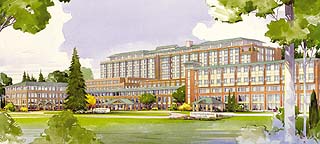
Anshen + Allen
Management: Derek Parker, CEO; Roger Swanson, president; Adam Kerner, Seattle office manager and principal
Specialty: Health care, academic building design
Year founded: 1940
2002 revenues: $66.5 million
Projected 2003 revenues: $70 million
Largest current project: Designing replacement of Sacred Heart Medical Center’s RiverBend Campus in Springfield, Ore.

Photo courtesy Anshen + Allen Sacred Heart Medical Center’s replacement campus in Eugene, Ore. |
Hospitals nationwide are working to make their facilities more comfortable by designing them to be more like hotels.
Architects from Anshen + Allen are part of a team that is instituting the concept on a major project: replacement of Sacred Heart Medical Center’s RiverBend Campus in Springfield, Ore. The approximately $300 million facility measures 1.2 million square feet.
So big is the assignment that staff from Anshen + Allen’s Seattle office is teaming up with colleagues from headquarters in San Francisco to design it for Peace Health, the Bellevue company that owns the hospital. But that’s only part of the story.
“The real key aspect of the RiverBend project is the teaming of Anshen + Allen with another architecture firm, WATG, that specializes in hospitality design,” said Adam Kerner, an Anshen + Allen principal who heads up the Seattle office. WATG is Wimberly Allison Tong & Goo, whose Mercer Island office is working on the project.
Anshen + Allen also is working on the master plan for Providence St. Vincent Hospital in Portland. The plan’s recommendation is to add more beds, which Kerner says is a trend. “I think we’re seeing there is still an unmet need for additional beds,” he said, explaining this is a result of hospitals’ emphasis on outpatient care over the last 15 years.
In building more space for beds, Kerner said hospitals are asking designers to develop “acuity adaptable rooms.” This means a patient does not have to be moved from unit to unit as his or her condition improves or deteriorates. The concept is fairly mainstream, but implementation still is new, according to Kerner.
A major issue hospitals face is development of specialty facilities, such as heart centers and cancer facilities, to capture high profits. “We have seen a lot of emphasis over the last few years on the heart hospital,” Kerner said, “and yet there is some talk those are being overbuilt.” The result may be a reduction of this sort of construction.
Other trends affecting the design and construction of health care facilities is the increasing frequency of robotics in surgery and bioengineering. Anshen + Allen’s Los Angeles office is designing the University of Washington’s $56 million bioengineering facility.
“As results of (bioengineering) research filters down, we will see some real revolutions in health care,” Kerner said. “We certainly see it as something on the horizon.”
He sees the health care side of the design industry continuing to be strong. “Things are still vibrant,” Kerner said, adding Anshen + Allen could add five staff members in Seattle and 20 in San Francisco.